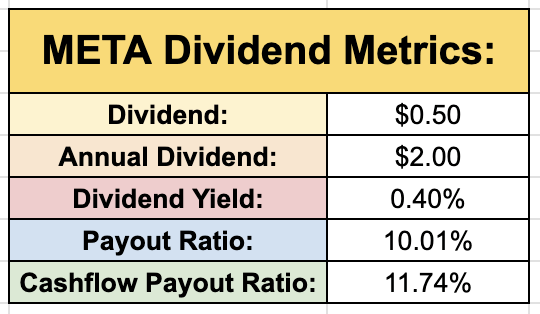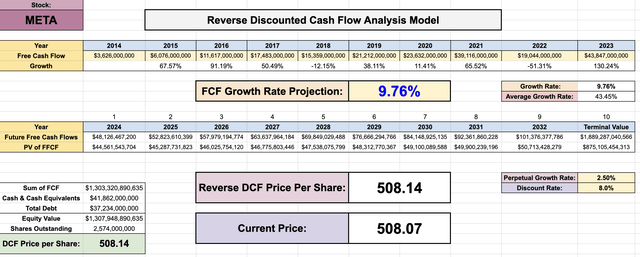Summary:
- Meta Platforms, Inc., a member of the “Magnificent 7” stocks, has seen significant returns and is a strong driver of the S&P 500.
- Meta Platforms recently announced its first dividend payment, indicating a shift towards becoming a dividend growth machine.
- Despite a low starting yield, Meta Platforms has the potential to increase dividend payments at a high rate due to projected EPS and FCF growth.
Justin Sullivan
Introduction
Meta Platforms, Inc. (NASDAQ:META) is a member of what is known as “The Magnificent 7,” which is a group of seven stocks that have seen phenomenal returns over the past few years. They have been strong drivers of the S&P 500 (SP500) hitting multiple new all-time highs over the past few weeks. META themselves is up over 155% in just the past year alone, and over 200% over the past 5 years, despite essentially burning billions of dollars on their failed “metaverse” project.
And in the midst of the current AI hype that is driving the magnificent 7 stocks to new all-time highs, META quietly has all the qualities of a stock that has the potential to become a dividend growth machine. While META currently is getting nearly all of their attention from growth investors, it’s time dividend growth investors start considering trillion dollar company.
Pay the Dividend!
In February of this year, META announced they would officially be paying out their first quarterly dividend payment ever in late March. This dividend payment would come out to be $0.50.
While many dividend investors rejoiced at this news, some people believe this is a bad sign for the company, as it indicates the rapid growth days are behind them. But paying out dividends is something META should have done years ago. Any time a company can’t intelligently reinvest their capital back into the business at a high rate of return, then that company should be paying out dividends.
When we look at META’s financials, we can see they generated around 135 billion in revenue in 2023, their cash and cash equivalents was sitting at $41.8 billion, and their total current assets is sitting at $85 billion, while their total debt is sitting at $38 billion. To put it simply, this company had more cash than they knew what to do with.
As a result, they tried to reinvest this capital back into the business by working on their Metaverse project, where they spent over $36 billion. This project proved to be a massive failure and essentially brought not returns to META. And in my opinion, this is what META to realize that they had more cash than they knew how to intelligently reinvest back into the business. This isn’t necessarily a bad thing. For example, Microsoft (MSFT) has seen explosive growth over the past decade, yet has also been very successful at paying a growing dividend over that time period.
The dividend payment redirects management’s focus towards focusing on the most profitable projects. Any cash that cannot be reinvested effectively should be returned to shareholders. When companies fail to do this, we get billions of dollars allocated to low ROI projects like the metaverse.
A Dividend Perspective
As a dividend growth investor with a long time horizon, I want to buy companies with low payout ratios and growing free cash flow, as this gives my holdings the ability to increase their dividend payments at a rapid rate.
META falls directly into that category. With their current dividend sitting at $0.50, this puts their starting yield at a low 0.40%, but also puts their payout ratio at just 10.01%, based off their forward EPS of 19.98. With last year’s free cash flow per share coming in at 17.03, this puts their free cash flow payout ratio at 11.74%.
META Dividend Metrics (Tickerdata.com)
Despite META’s low dividend yield, with their projected EPS and FCF growth being high and their payout ratio remaining very low, this company has massive potential to increase their dividend payments at a high rate over the next decade and on. While the yield is low now, an investment into META now would likely lead to an eventual high yield on cost, as the company increases their dividend payments over the years.
Chief Financial Officer Susan Li told analysts the following on their recent earnings call:
The dividend doesn’t change how much we will be — or it doesn’t change the way we determine the total amount of capital we return. And we expect that share repurchases will continue to be the primary way that we return capital to shareholders. But introducing a dividend just gives us a more balanced capital return program and some added flexibility in how we return capital in the future.
Looking historically, it’s clear META’s free cash flow supports a growing dividend. Free cash flow went from 2.86 billion in 2013 to 43.8 billion in 2023. With that being said, it’s important to note that Chief Financial Officer Susan Li did mention that the company still expects share repurchases to be the main way that META returns capital to shareholders.
META free cash flow growth (Tickerdata.com)
Valuation
Typically when I value companies, I find that the discounted cash flow analysis is often the most effective way to find fair value. But in the case of stocks in the Magnificent 7, I believe it can make more sense to utilize a reverse discounted cash flow analysis to find exactly how much free cash flow growth is currently priced into this stock.
With META currently trading at around $508 a share, assuming an 8% discount rate, there is currently about 9.76% free cash flow growth priced into this stock annually over the next decade.
META Reverse discounted cash flow analysis (Tickerdata.com)
The question we must ask ourselves, is this growth price into the stock justified? And simply by looking at historical free cash flow growth rates and looking at future revenue growth projections, it’s not unrealistic to argue that free cash flow growth over the next decade could exceed the 9.76% that is currently priced into this stock.
Risks
After carefully reviewing META’s Form 10-K and reviewing the list of risks associated with META, I believe the main risks of owning this stock are the following:
- Reduced availability of data signals used by META’s ad targeting and measurement tools
- Acquisitions and the ability to successfully integrate acquisitions
- Government restrictions on access to Facebook or other products, or other actions that impair META’s ability to sell advertising in certain countries
- The ability to obtain, maintain, protect, and enforce META’s intellectual property rights.
While these risks don’t appear to be an immediate threat in META’s current business environment, it is entirely realistic that any one of these could cause headwinds down the road.
Final Thoughts
While some growth investors believe that META initiating a dividend is a sign that the company’s rapid growth days are behind them, I’d argue the opposite. META paying a dividend isn’t a sign that the company’s high growth days are behind them, it’s simply a sign that the company is generating more cash than they know how to intelligently reinvest back into the business. This is the exact “problem” that Microsoft and Apple (AAPL) have been dealing with for some time now, and we’ve seen from them that this is a great problem to have.
While I haven’t personally added shares of META to my portfolio, it could potentially be a solid option for investors looking to reap the benefits of META’s future. We see rapidly growing dividend payments as a result of Meta Platforms, Inc.’s growing free cash flow and massive cash pile the company is currently sitting on.
Analyst’s Disclosure: I/we have no stock, option or similar derivative position in any of the companies mentioned, and no plans to initiate any such positions within the next 72 hours. I wrote this article myself, and it expresses my own opinions. I am not receiving compensation for it. I have no business relationship with any company whose stock is mentioned in this article.
Seeking Alpha’s Disclosure: Past performance is no guarantee of future results. No recommendation or advice is being given as to whether any investment is suitable for a particular investor. Any views or opinions expressed above may not reflect those of Seeking Alpha as a whole. Seeking Alpha is not a licensed securities dealer, broker or US investment adviser or investment bank. Our analysts are third party authors that include both professional investors and individual investors who may not be licensed or certified by any institute or regulatory body.
